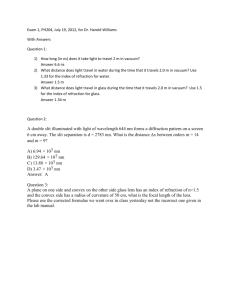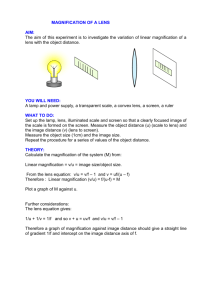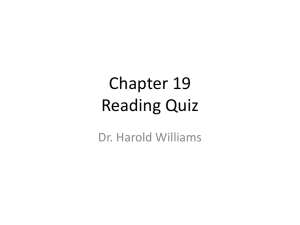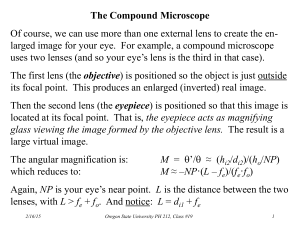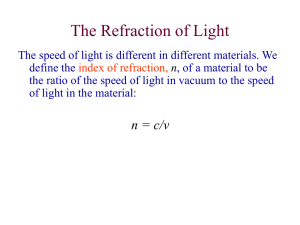refraction and thin lenses
advertisement
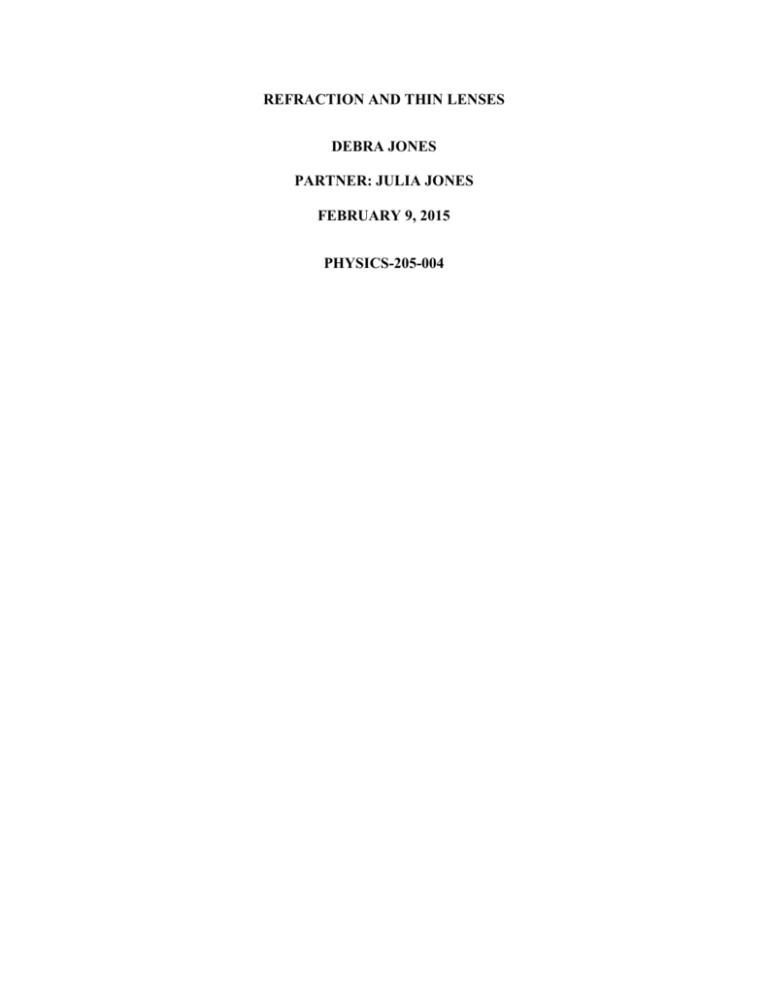
REFRACTION AND THIN LENSES DEBRA JONES PARTNER: JULIA JONES FEBRUARY 9, 2015 PHYSICS-205-004 Abstract: The purpose of this experiment was to measure simple refractive systems via use of the ray model of light. The first part of the experiment used water in an index refraction apparatus in order to observe how the angle of refraction changed with different angles of the leaver arm on the apparatus. This was done by first setting the lever arm at 10.0° and aligning top line on the bug on the back wall of the refraction tank with the etched line on the apparatus and the hairline on the lever arm. Next, the lever arm was repositioned so that the hairline and the etched line were set to match the bottom line of the bug that was in the water. This process was repeated for the angles of incidence θ= 15.0, 20.0, 25.0, 30.0, 35.0, 40.0, and 45.0°. The angles of refraction that were found for each angle of incidence, in order, were 11.0°, 13.5°, 18.0°, 23.0°, 27.0°, 49.0°, 53.0°, and 58.5°. From each of these angles, the index of refraction of the water was calculated (using nr of air=1.00029) to be 1.84, 1.24, -0.823, 6.40, -0.968, 2.23, 0.532, and 1.09 respectively. Next, sinθi was plotted against nrsinθr, and the slope was used at the experimental index of refraction of water. This value was found to be 0.192, and the percent error was calculated to be 85.6%. A possible source of error would be that the hairline, the etched line, and the bug line were not lined up properly. One issue that was faced during the experiment was that at certain angles, the bottom line of the bug was not able to be viewed, so the trial had to be repeated. The purpose of the second part of the experiment was to find the focal length of a thin lens, and to determine the magnification, image distance, and object distance using double convex lenses. The object and image distances were found by placing a light source, a screen (the image), and a 100mm focal length convex lens on an optics bench. The image was 60 cm away from the light source. The lens was then moved slowly away from the screen until a focused image appears. The first object distance, image distance, object size, and image size were found to be 0.476 m, 0.124 m, 0.020 m, and 0.006 m respectively. The second object distance, image distance, object size, and image size were found to be 0.120 m, 0.480 m, 0.020 m, and 0.081 m. These measurements were used to calculate the focal lengths and the magnification of the two lens positions. The focal length of the first lens was 0.098 m, while the second was 0.096 m. The percent error for the focal lengths was 2.88%. The magnification calculated for the first lens was found to be -0.261 for the distance, and -0.274 for the size. For the second lens, the magnification of the distance was -4.00 while the magnification for the size was -4.02. The percent error for the first and second magnifications were 4.92% and 4.22% respectively. A possible source of error could be due to the lens not being adjusted to the position where the image is most focused. There seemed to be a range of distances where the image appeared relatively clearly. The third part of the experiment involved construction a telescope out of a 100 m focal length eyepiece, and a 200 m focal length objective lens. The eyepiece was placed 1.06 m from the object, and the objective lens was placed 0.770 m from the object. The observed magnification of the telescope was found to be 20.0 while the calculated magnification was found to be 18.8. This was done by using the distance of the object to the objective lens (0.770 m) and the distance of the object to the eyepiece lens (1.06 m). The percent difference was calculated to be 6.39%. Possible sources of error could be due difficulty encountered when attempting to observe the object in parallax. The fourth part of the experiment involved the construction of a microscope by using a 200 mm focal length lens as the eyepiece and a 100 mm focal length lens as the objective lens. The objective lens was positioned 0.180 m from the object, and the eyepiece was 0.590 m from the object. Using so (0.160 m) and –se’ (0.590 m), the magnification was calculated to be 6.86. Compared to the observed magnification of 10, the percent error was found to be 37.2%. A possible source of error could be due to difficulty comparing the observed magnified image to the relative size of the object itself. Discussion: 1) 2)
